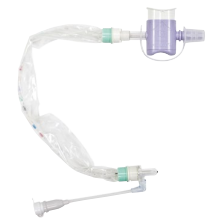
Closed Suction System
Closed systems for suctioning the airways of mechanically ventilated patients are of immense importance in terms of safety for both patients and medical personnel. Each time the circuit is opened, medical staff are exposed to potentially infectious material carried by air particles, which also represents a significant risk factor for cross-infections.
Patient safety is also at risk when using open suction systems. Disconnecting the respiratory circuit can lead to hypoxemia, atelectasis, or lack of lung re-expansion. Disconnecting the respiratory circuit for catheter replacement, bronchoscopy, and Mini-BAL are classified as high-risk procedures [1,2]. [1,2].
The answer to these challenges is closed suction systems, which allow for procedures such as suctioning, bronchoscopy, and drug administration without the need to disconnect the respiratory circuit. This solution also enables catheter replacement without opening the circuit, thereby helping to minimize the risk of exposing staff to pathogens from the patient’s airways.
[1] Ofner M, Lem M, Sarwal S, et al, for the SARS Investigative Team, Centers for Disease Control. Cluster of severe acute respiratory syndrome cases among protected health careworkers, Toronto, Canda, April 2003, MMWR Morb Mortal Wkly Rep 2003;52(19):433–6.
[2] Loeb M, McGeer A, Henry B, Ofner M, Rose D, Hlywka T, Levie J, McQueen J, Smith S, Moss L, Smith A, Green K, Walter SD SARS among critical care nurses, Toronto. Emerg Infect Dis. 2004 Feb;10(2):251–5

 Polski
Polski